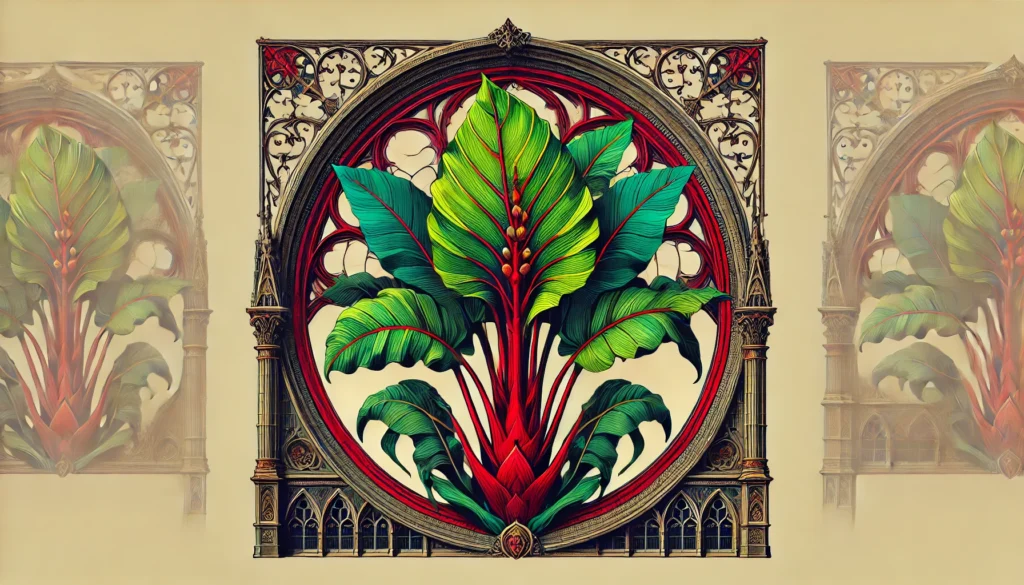

Home » Cat Plants » The Toxic Dangers of the Pie Plant Plant to Cats

Pie Plant, more commonly known as Rhubarb (Rheum rhabarbarum), is a perennial vegetable often used in desserts. While the stalks are edible for humans, this plant can be toxic to cats if ingested, particularly the leaves.
Rhubarb is commonly found in gardens and is popular for its tart flavor in pies and other culinary uses. Cat owners should be aware of the potential dangers this plant poses to their feline companions.
Ingestion may cause mild gastrointestinal upset, but is generally not life-threatening.
Ingestion can result in mild symptoms like vomiting, diarrhea, or drooling. Rarely fatal but may require veterinary care.
Eating these plants can lead to more pronounced symptoms like abdominal pain, lethargy, or difficulty breathing. Veterinary intervention may be necessary.
Ingesting even small amounts can cause severe symptoms like organ damage, seizures, or cardiac failure without rapid treatment.
All parts of these plants are extremely poisonous to cats and can quickly lead to death, even with immediate veterinary care.
** Please note: Please note that toxicity level can vary based on the amount ingested and the specific cat. It's always best to keep these plants completely inaccessible to cats and seek immediate veterinary care or call the poison hotline if you suspect your cat has ingested any part of a toxic plant.
If a cat ingests parts of the rhubarb plant, particularly the leaves, they may experience various symptoms due to the plant’s toxic compounds. The severity of symptoms can depend on the amount ingested and which part of the plant was consumed.Common symptoms of rhubarb poisoning in cats include:
It’s crucial to monitor your cat closely if you suspect they’ve ingested any part of the rhubarb plant, especially the leaves.
If you suspect your cat has ingested rhubarb, it’s essential to seek veterinary care immediately. Your veterinarian may follow these steps to diagnose and treat rhubarb poisoning:
The veterinarian’s primary concern will be addressing the oxalic acid poisoning that rhubarb leaves can cause, which can lead to kidney problems if left untreated.

A: Yes, the Pie plant is harmful to cats due to its oxalate crystals, which can cause kidney failure. The leaves and roots are the most toxic parts of the plant, so it’s essential to keep it out of your cat’s reach.
A: If a cat eats the Pie plant, it may experience symptoms like vomiting, drooling, and kidney damage. Immediate veterinary attention is recommended to avoid severe health issues.
A: Yes, all parts of the Pie plant, particularly the leaves and roots, contain soluble oxalates that are toxic to cats. These substances can cause kidney failure if ingested in significant quantities.
A: To protect your cat, ensure that the Pie plant is kept in areas your cat cannot access. Consider opting for non-toxic alternatives like cat grass or bamboo to create a safer environment for your pet.
A: Common symptoms of Pie plant poisoning in cats include vomiting, excessive drooling, and signs of kidney distress like lethargy. If your cat displays any of these symptoms, contact a veterinarian immediately.
A: While rinsing your cat’s mouth might provide some relief, it’s crucial to seek veterinary care for Pie plant poisoning. The vet may need to administer fluids and medications to prevent kidney failure and other complications.
The pie plant, or rhubarb, originated in China over 4,000 years ago as a medicinal herb. It spread to Europe via the Silk Road, valued for its roots. Culinary use began in the 18th century when sugar became more affordable, with England leading the way in rhubarb cultivation.
In North America, rhubarb gained popularity in the early 19th century. Pioneers called it “pie plant” due to its common use in desserts. By the 1820s, it was widely available in New England markets. Today, rhubarb remains a beloved ingredient, especially in pies, preserving its legacy as the “pie plant.”
Please note: The information shared in this post is for informational purposes only and should not be considered as veterinary medical advice.
🐾 A hilarious or heart-melting cat video
🐾 Our latest paws-on review of a cool cat toy